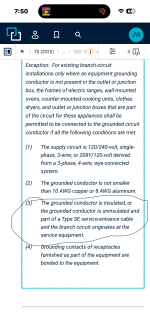ShockaBrah
Member
- Location
- New Hampshire
- Occupation
- Master Electrician
Okay, so I am trying to wrap my head around this. I am planning a service upgrade (resi, 100A to 200A) ( we are on 2020 code cycle) and I want to install a square D HOM Meter disconnect that also has an 8 circuit bus bar mainly because it is like $250 cheaper than the Milbank. Originally I had planned on marking emergency / service disconnect and running a 4-wire to a main lug panel inside the house, however, this afternoon I discovered that I have an existing 3-wire Range circuit so I cant use the meter enclosure as a SERVICE DISCONNECT and will need to install a MBP. I am trying to decide weather or not it would be acceptable to keep the enclosure, marked as Emergency disconnect not service equipment, run a 3-wire to the MBP marked as service disconnect and make all bonds inside the MBP. It feels wrong to have those extra spaces available ahead of the service disconnect, but as I look at 230.70, the first sentence says "Means shall be provided to disconnect all ungrounded conductors IN a building or structure from the service conductors". It specifically says IN a building not ON (outside) a building. What do you guys think about this? Alsop I am aware that I could potentially run a separate EGC to the Range and change the receptacle and cord but would rather not do that. Although that may be the simplest solution. ANYWAYY, any thoughts are good thoughts.
And as aways thanks in advance.
And as aways thanks in advance.


